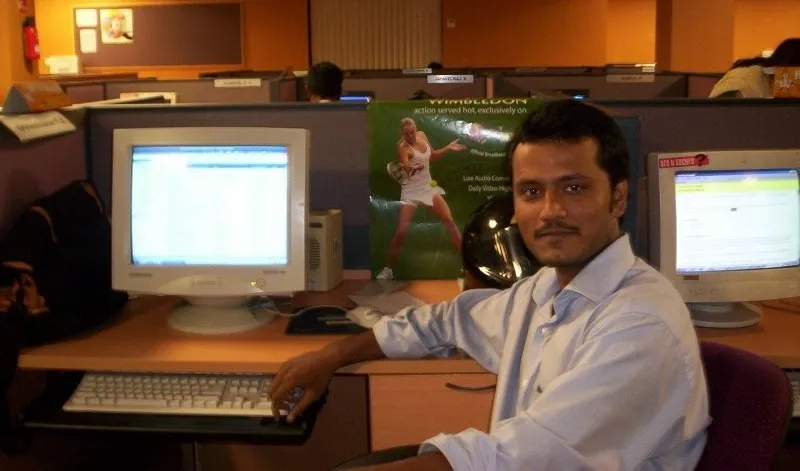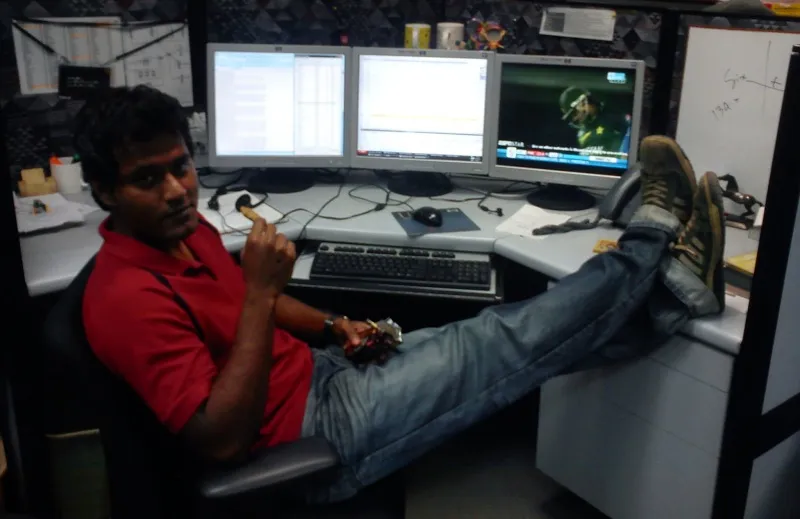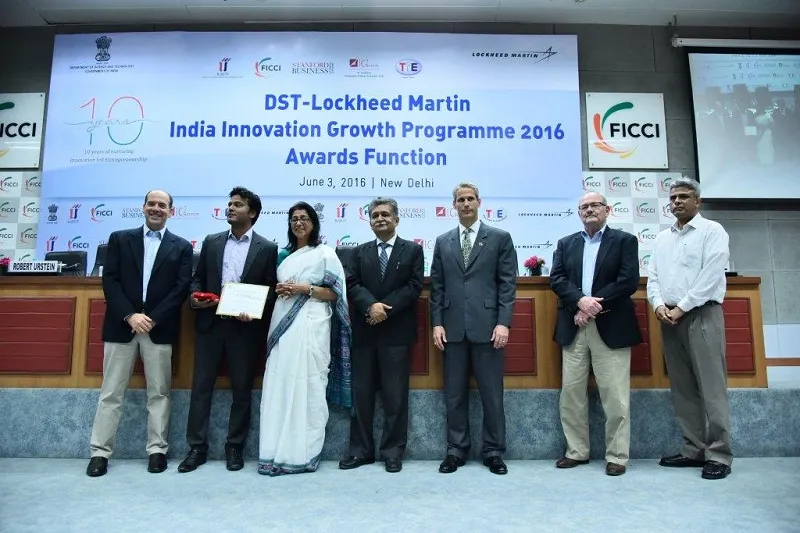[Techie Tuesdays] From assembling computers to aggregating networks, how Srix Sriramkumar is solving India's connectivity problem
This week, we bring to you the story of a hardware engineer working in the network and broadcasting domain to solve a genuine problem in India – internet speed and connectivity. Read about Srix Sriramkumar’s journey from assembling computers in Chennai to aggregating networks across three countries.
In 2004, Srix Sriramkumar graduated from Cresent Engineering College Chennai, and resolved, with three friends, that they would start a business in 2010. Six years later, two of them quit their jobs, with Sriram following suit after a few months. All three worked on an idea that unfortunately hit a roadblock within a few months, leading them to give up on the idea and two of the team members to leave. Sriram was left alone. This was precisely the point at which Sriram’s startup journey began. But Sriram’s tryst with hardware started much earlier, in his college days.

Sriram had worked in Motorola and Tektronix, where he gained exposure to broadcasting and network devices. This laid a strong foundation for his journey ahead with Watchy Tech (now Zifilink). In this week’s Techie Tuesday, we chronicle Sriram’s tryst with hardware and technology.
The Chennai boy
Sriram was born in 1983 in Chennai, where his father worked with the Department of Telecom. Growing up, he was an extrovert. He attended a CBSE school till the tenth standard, and feels indebted to the teachers there for shaping him up in his early days.

His school was one of the very few schools in Chennai that invested heavily in computers, with as many as 30 systems at the time (a big number in 1994-95). Though computers were introduced to students in the eighth standard, Sriram got his hands on the device before that. His father’s office had mainframe computers on which he tried to run FoxPro programs when he was in the seventh standard. His grandmother, who was running a school in Chennai, also had a computer, and so he started learning computer programming during his summer vacation. By the time Sriram reached the tenth standard, he was building small games in BASIC. In 2001, he joined Crescent Engineering College to pursue computer science engineering.
Sriram got a computer at home during his first year of college. He started spending a lot of time on the computer, and used to program a lot and release them on a website. His college friends downloaded these programs, changed the name, and submitted them as their own projects. Soon, Sriram and a few of his friends started thinking on ways to make some money, and eventually started selling assembled computers. In order to source the customers, they visited cyber cafes nearby and convinced the owners to send to them people who were looking for assembled computers (in return for which, he would get a commission). They made almost Rs 1,000 per system. They even started fixing systems (specifically internet issues) where the usual issues were a cut dial up line or a corrupted modem driver. With these, they were able to make a good amount of pocket money.
In 2004, the Indian government passed a regulation that all cable TV access should be through set top boxes, and the first city to be mandated was Chennai (though it took almost six years on the ground to achieve 100 percent coverage). It was announced then that in two months, Chennai would become completely digital. Sriram and his college friends decided to work on the idea of a software-based set top box for people who have a computer at home. They used open source applications and a TV tuner card to build this. Their college submitted it to the Tamil Nadu government, which selected it as the best project of the year and provided money to aid in its execution.
Also read - The story of a hardware genius, Anool Mahidharia
On the top of the set top box
Sriram joined Sify (Satyam Infoway Ltd.) in 2004. The company was, at the time, planning to do something in the set top box space, but later moved away from it. Sriram ended up working on Sify Messenger, which was supposed to be a Yahoo Messenger killer. It had a video conferencing facility, which was Sriram’s responsibility. Unfortunately, the product was never launched in the consumer market.

After a year at Sify, Sriram joined Motorola, which was then beefing up its set top box unit in Bengaluru. They wanted people who had experience in set top boxes, and Sriram fit the bill. Initially, he worked in a set top box testing team, but an incident that took place after six months changed a lot of things for him. He recalls, “One of the customers had a problem. Their set top box was getting restarted. The development team was busy in the US, and they passed this on to us, since we were writing the test cases for it. Within half a day, we found the bug.”
The bug was in the C++ code, which was implementing an MPEG descriptive standard. MPEG moves in frames, and after each frame, the cache has to be cleared. The current code wasn't doing that, due to which the cache was getting full and the system was resetting. It was sent to the developer team in the US and was fixed.
Sometime later, when Motorola started the developer team in India, Sriram joined their set top box unit. He went to the US to take up a development project that they were then moving to India. Whenever a new set top box was launched by Motorola, it was manufactured at the Foxconn centre in China. Sriram’s job was to set up a shop floor at Foxconn for this manufacturing. It was very critical that the whole shop floor software was controlled by Motorola, given that these were IP set top boxes with secret keys that could decrypt the content. Sriram explains, “Each box has a different key. Our software running there provisions these keys in each box. If that key leaks, the content leaks; so we couldn't have offloaded this process to any other company."

Though Foxconn manufactures the set top boxes, they then connect them to a system which runs Motorola's software which flashes the operating system, configures the one time programmable keys, and attaches a serial number.
When a video comes into a set top box, it's all encrypted. The secret key in the set top box decrypts the video, and this key varies with each set top box. Only the US facility (a separate facility in the Motorola HQ) generated this key. This software took care of PKCS (Public Key Cryptography Standards) and other standards for exchanging keys secretly (and then flashing it). While Foxcon manufactured the set top boxes, they then connected them to a system that ran Motorola's software, which flashed the operating system, configured the one-time programmable keys, and attached a serial number.
When Sriram took over the software, it wasn't scalable and didn't have distributed base. He and his team built the distributed database so that the same software could be used in multiple manufacturing facilities.
You may also like - Started bounty hunting for a job, Anand Prakash made 1.1 crore with his passion
After two and a half years at Motorola, the software became stable, and there were no development activities happening. That's when Sriram joined Tektronix. Tektronix manufactured equipment for testing video products. For example, if you build a set top box, you have to make sure that it works when a correct MPEG stream comes through. It should also handle the cases when the stream might be corrupted, which occurs sometimes. Tektronix helped in simulating these situations (and more) by generating clean streams and corrupted streams that could be fed into the system (to check the performance/output).

It was common for the broadcasting and mobile industries to use this product to test their firmware. During his stint at Tektronix, Sriram gained exposure to the broadcast industry and MPEGs. Globally, IP video traffic will be 82 percent of all consumer internet traffic by 2020, up from 70 percent in 2015. High throughput networks are video networks. By then, Sriram had an idea of how to build a high throughput network and what the problems with it were. With this expertise, he decided to start up on his own.
The six-year-old promise to startup
In 2004, Sriram and three of his friends decided that they would start a business together in 2010. After their graduation, they met regularly and discussed ideas. Infosys was a big inspiration for them. In 2010, when the time came, two of the three friends (working with Alcatel and Ramco Systems) quit their jobs. Sriram could join them only after a few months, but the trio started discussing ideas and working on the concept.
They were building a hardware device that could be connected to the TV or set top box and form a channel for personal content (like photos, videos). It would be connected to the internet and could sync every time the images were uploaded on target platforms (like Facebook). The photos could then be downloaded and saved in local memory. Sriram says, “We just started working on the hardware part and realised the compact hardware, low voltage, and lack of open source embedded boards made things complicated, and we decided to give up.”
In the meanwhile, Google announced the launch of Google TV, and Sriram started thinking about the application that could be written on top of the Google-launched programmable set top box. That’s how he landed on the idea of live streaming weddings (for people who can't travel). He tried working on it, but faced multiple issues like the web camera not focusing on objects at great distances, unclear audio, and poor internet connectivity. Even though 3G was launched, it wasn't up to expectations. Sriram realised that nobody was addressing the problem of sending high data content over the internet. He says, “We were thinking along the lines of combining multiple 3G connections to get the high capacity (equal to the summation of individual's bandwidth).”
Related read - Jishnu Mohan: The 27-year-old developer who made Indic Keyboard before Google did
Getting to high speed and reliable internet
In 2011 and 2012, Sriram worked on the proof of concept of his idea of combining multiple networks to get more bandwidth. His first team member joined him in January 2012 to help him with the live streaming of events. Watchy Tech (now renamed Zifilink), the startup founded by Sriram, then became a wedding live-streaming company. They could finally aggregate multiple cellular networks to get an increased data speed. They then built a hardware device by taking an open source hardware and flashing all softwares. This directly takes inputs from the camera (or handycam), digitises and compresses the video, and then streams over an aggregated connection speed. But they were hit by the market reality that things have moved to HD (while theirs was an SD product). They were five people then, and the company was yet to break even. Sriram recalls,
“I had two choices then. Build an HD product or narrow down the approach to work on only network aggregator. We went ahead with the latter.”
In 2014, the startup saw a stroke of serendipity, and big brands launched portable encoders. Basically, earlier, after recording videos on a camera, the cameraman used to come to the studio, encode it, and then put it online from there. Portable encoders could now be carried to events, and with it, there was no need to put in an SD card. An encoder compresses the content and output can be pushed into internet. With these encoders in the market, the brands only needed something to help them push the videos to the internet. It was then that the distributors of these brands approached Watchy Tech for the solution and the company launched its product in the market. Since then, the product has gone through iterations only in terms of performance-improvement and hardware. The company manufactures its product in India.

The tech in Watchy Tech
Initially, Sriram and his team started with the Leopard Board and then moved on to BeagleBone. All the prototypes were demonstrated on the open source boards. Since the development cycle was longer in ARM-based platforms , the company shifted to the Intel-based platform midway through. The first PoC was built on Texas Instrument (TI) OMAP media processors, but since TI withdrew from the OMAP series (and mobile business), they had to change it. The product was called ‘Bond 007’, as it was doing a bonding of seven networks (it can now bond eight).
The company recently rebranded as Zifilink. Its tech stack includes Linux (operating system) and Python (applications). Most of the tools are open sourced. Sriram says, “One part of the team works on embedded devices and system programming, and the other works on the cloud component. The whole solution requires a cloud component to be running, which accesses a network proxy.”
Sriram believes that even with a broadband connection with 100mbps speed, businesses need a backup as even a two or three-hour disruption can cause big losses. Hence the company is now positioning itself away from the media market to the general purpose market. By combining eight different networks, Zifilink reduces the chances of network downtime. Also, at places where broadband isn't available and the only possibility is wireless, Sriram finds it easy to sell his product, which offers combined bandwidth (speed) of multiple networks and a minimal downtime. This year, Nepal, Bangladesh, and India will be the company’s focus, while it also intends to experiment in the US.
For Sriram, more than the hardware, the space (broadcasting and network) has excited him. His company has filed five global patents till date. One of these is about aggregating network in mobile phones(multiple SIM, increased bandwidth, high-speed, reliable internet).
Also read: Meet Arun Ganesh, the 29-year-old map man of India
A challenging journey
Before Zifilink became profitable, it was tough for Sriram to balance between the investments in R&D and supply chain, and day-to-day operations. He says,
It’s very difficult to plan big when you're running low on cash.
Sriram believes that his investors and teammates have helped him a lot in overcoming challenges. They could see where the company was heading and had full faith along the way. Sriram says, “Till Watchy Tech got a good response from the market , we were taking a very small salary. It demands good amount of sacrifice in personal life and a lot of explanation to the family in such situations. We sustained for two years to reach where we are.”
Sriram believes that any core tech company takes multiple years to build. According to him, innovation comes when you can figure out different ways of reaching out to the same goal. He says,
Innovation isn’t about setting up a different goal, but to help you in reaching your current goal by providing an alternate(and more efficient) route.
Sriram is happy building Zifilink for now, as he believes that it’s solving a genuine problem. He simply wants to be known as someone who has built a genuine innovation (solving a genuine problem) from India.
You can connect with Sriram on LinkedIn.


![[Techie Tuesdays] From assembling computers to aggregating networks, how Srix Sriramkumar is solving India's connectivity problem](https://images.yourstory.com/cs/wordpress/2017/04/Shriram-with-logo.jpg?mode=crop&crop=faces&ar=2%3A1&format=auto&w=1920&q=75)




